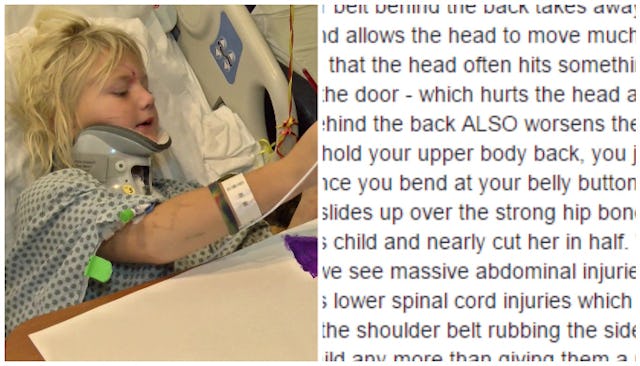Mom Warns Others After Seatbelt Mistake Almost Cost Child Her Life

The mother of a 6-year-old girl admits seat belt mistakes to warn others
You’re going to be questioning your car seat use, your booster seat use, and how your kids wear their seat belts after hearing what happened to this young girl.
A 6-year-old girl in Virginia has a long road to recovery right now, but she’s on the mend. Little Samantha just got out of the hospital three weeks ago after being in a car crash with her dad coming back from a county fair. They struck a tree. Samantha wasn’t in a booster seat because her mother thought she had outgrown it. The girl had also taken the seat belt, like so many kids, and put the top portion behind her back. The girl’s mom, Shelly Martin describes what it’s like getting the initial phone call in this video from WWBT News 12 in Richmond.
NBC12 – WWBT – Richmond, VA News On Your Side
“It’s awful, I mean it’s torture. You know what I mean? Your mind kind of thinks of all sorts of things. They told me she had facial and head injuries and stomach lacerations and that she was still in surgery and that’s all they would tell me for a couple of hours,” Shelly told local news, WWBT News 12 in Richmond.
Turns out, Samantha was lucky to be alive. The doctors explained that the far edge of the seat belt cut through her abdomen and caused her intestines to come out of her body. The doctor who operated said Samantha was essentially “cut in two.” He said most of it couldn’t be repaired.
Image via WWBT
Samantha suffered from what medical experts call “seat belt syndrome.” Injuries from seat belt syndrome are categorized by spine, abdominal, and head injuries and are caused when only the lap portion of any seat belt is worn.
Samantha is home now and had to have a binder around her belly to hold it together until she’s healed. After all she went through, Shelly is now urging parents to understand exactly how child safety seats work, how seat belts should be worn, and when it’s OK to move a kid from their safety seat. She’s speaking out against the dangers, even if it means admitting her and Samantha’s father’s mistakes.
“A lot of people seem to think that when the children don’t fit so easily in the booster, that it’s okay to take them out of the booster. That’s not the case,” said Shelly.
Shelly is exactly right and expert tips back her up. According to The Car Seat Lady, the harness straps must be snug like a hug on a child… snugger than most parents think they should be and snugger than most parents make them.
The other factor to consider is whether your child is ready to move to a booster seat. “With many seats going to 65 pounds and some to 90 pounds with the harness, it is not required that the child reach the limit of the car seat before moving to a booster,” Alisa Baer of The Car Seat Lady tells Scary Mommy. “On the flip side, there are some car seats that have very low height and weight limits such that many three-year-olds will be too big for them… and three year olds are not ready for boosters. With the way many of the car seat head rests are designed, the child would need to be about 10 inches too tall for the seat before their ears started peeking out above the top of the car seat.”
Lastly, Samantha moved the shoulder strap behind her in the car. According to Baer, “doing so increases injury risk to the abdomen and lower spinal cord as without the shoulder belt to hold your upper body back, you now jack-knife over yourself in a crash, and since you bend at your belly button and not your hip bones, the lap belt slides up over the hip bones and to the belly button area. With the lap belt on the belly button area, all the crash forces are now applied to the middle of the abdomen which is not strong enough to withstand all the crash forces and the lap belt can literally cut through all the soft internal organs (as happened to the child in the story) and can go deep enough that it even tears through the lower spinal cord leaving the child paralyzed.”
Shelly recounted sleeping every night by her child’s side in the hospital. And the aching feeling that it didn’t have to be that way.
“Because stuff happens so quickly, so quickly,” said Shelly. “And you’ll just be, I mean, there’s always going to be that guilt about, ya know, we should’ve done better. This was completely avoidable.”
[free_ebook]
This article was originally published on